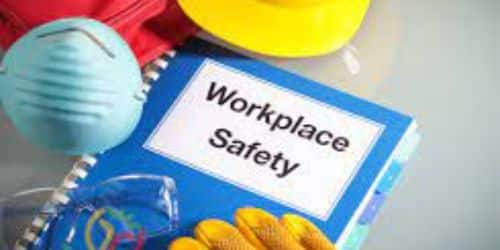Safety should never be neglected, especially at work where employee welfare directly affects company effectiveness. So, if you want to increase productivity at work, you must integrate workplace safety into your organization’s culture. Learn about frequent workplace risks and accidents, workplace health and safety examples, importance, and tips on how to prevent mishaps in this article.
Workplace Safety
The term “workplace safety” relates to preventing hazards, accidents, and other undesirable consequences at work. It is the result of a number of regulations, practices, and safety measures that aim to reduce risks, mishaps, and other types of harm in the workplace. The majority of the time, workplace safety has a direct impact on the efficiency and health of your staff, and these factors have a direct impact on the caliber of the output of your company. Therefore, companies must work to create a secure atmosphere that presents all workers with a manageable amount of risk.
Additionally, workers must be fast to spot circumstances and conditions that could endanger their safety or expose them to unacceptable risk levels. The Occupational Safety and Health Administration (OSHA) is responsible for enforcing workplace safety laws in the United States.
Types of Workplace Hazards and How to Prevent Them
Here are a few types of workplace hazards and some preventive measures:
#1. Electrical Accident
Unprotected exposure to high-voltage electrical outlets is the primary cause of electrical mishaps, which are highly frequent in the workplace. Electrical risks in American workplaces result in more than 300 fatalities and 4,000 injuries annually, according to the Electrical Safety Foundation International. The three main categories of electrical mishaps are electrical burns, electrical fires, and electrical shocks. Electrical shocks happen when your body comes into touch with electricity and the current flows through you; in extreme circumstances, this can cause heart failure or respiratory failure.
#2. Exposure to Dangerous Chemicals
Employee safety can also be hampered by toxic chemicals in the workplace, particularly if workers are exposed to these compounds without taking the necessary precautions. The repercussions of chemical exposure can range from cancer and organ failure to death. As they go about their everyday business at work, people could come into contact with a variety of dangerous compounds.
#3. Workplace Harassment
A frequent issue, workplace harassment can lead to harmful behaviors, a poor working atmosphere, and decreased productivity. It includes any behaviors that persistently harass, abuse, mock, or discriminate against an employee(s) and may have a negative impact on how well they perform at work.
#4. Fire Mishaps
A workplace fire accident is an extremely dangerous risk that could lead to property loss and human casualties. According to a US Bureau of Statistics estimate, over 5,000 additional workers suffer minor to significant injuries each year, while about 200 workers perish in workplace fires and explosions.
#5. Employee Theft
When an employee unlawfully takes money or non-cash assets from their employer, it is called workplace theft. Employees who steal from their employers frequently do so in an effort to settle accounts with them or to exact revenge for unfair pay or other harsh working conditions.
#6. Existing Medical Conditions Among Workers
Workers who have underlying medical issues are more vulnerable to workplace accidents, such as those caused by chemical exposure. Employers must take care to accurately record the medical histories of their staff members and conduct pre-employment physicals.
#7. Construction Site Accidents
Construction sites are hazardous environments where accidents can result in injuries, fatalities, and property damage. Common accidents include falls from ladders, scaffolding, roofs, or elevated work platforms due to inadequate fall protection or improper safety equipment use. Accidents involving workers getting caught or crushed by heavy equipment, like bulldozers or large materials, are another frequent occurrence.
Trench and excavation collapses can trap or bury workers, posing risks of suffocation or crushing injuries. Equipment accidents result from operator error, malfunction, or insufficient training when operating cranes, forklifts, and other heavy machinery. Slips, trips, and falls are caused by uneven or slippery surfaces, clutter, or poorly maintained walkways. Overexertion injuries like strains and sprains can result from manual labor and heavy lifting.
Scaffolding accidents can occur due to structural defects, inadequate training, unsafe working conditions, falling objects, and negligence. A scaffolding accident lawyer plays a crucial role in such cases by investigating the accident, identifying responsible parties, advocating for compensation, guiding clients through legal procedures, and ensuring compliance with safety regulations and industry standards.
To prevent construction site accidents, strict adherence to safety protocols, personal protective equipment use, adequate training, and regular equipment maintenance is crucial. Government agencies enforce safety regulations to ensure a safe working environment, and reporting unsafe conditions and near-misses can help prevent future accidents.
Health and Safety Workplace Examples
What are some workplace-friendly health and safety procedures examples? There are many of them, but we’ve whittled the list down to the greatest health and safety measures examples you can implement at work. These are them.
#1. Have Your Eyes Examined
For example, adequate lighting is essential for both your health and safety—both for your own and other people’s vision. Additionally, many general workplace safety practices are simple to overlook: Always have your eyes examined, and if you require them, buy a set of ergonomic glasses.
#2. Quit Smoking
Employers must encourage healthy and safe behaviors among their staff in today’s cutthroat industry. Smoking is unhealthy, so you should abstain from doing it if you are around coworkers who don’t want to be exposed to secondhand smoke at work or around you. Consider implementing a zero-tolerance policy on smoking at work as part of a proactive strategy to offer a safe and healthy workplace for all employees.
#3. Employ the Proper Tools
No matter what sector you work in, your workplace’s health and safety procedures can affect whether your employees are happy and fulfilled in their work or anxious and disengaged. For instance, the Bureau of Labor Statistics (BLS) reports that 95% of offices have ergonomic risk factors due to a lack of employee-appropriate gear. Lack of the proper equipment results in repetitive stress disorders like carpal tunnel syndrome.
#4. If You Are Concerned About Your Stress Levels, Speak to Your Doctor
Many people release their tension by smoking, consuming unhealthy foods, or engaging in excessive alcohol use. It could be a good idea to discuss the various treatments available with your doctor if you feel that your stress levels are out of control.
#5. Take Regular Breaks From Your Screen
Workers who took breaks from their computer screens had better eyesight and committed fewer errors than their peers who remained concentrated on one activity, according to a meta-analysis from 2003. If you spend a lot of time at a computer at work, try taking regular breaks—stand up and move around, set an alarm, or take a quick nap—to ease eyestrain and boost focus. With these safety practice examples at work, you might not save any lives, but you’ll definitely save your own!
#6. Avoid Back Strain With Ergonomic Desk Chairs
Desk chairs with good ergonomics reduce back pain. After a long day of working at our desks, we might not realize how uncomfortable we are until aches and pains start to show. To avoid having to rely on anything less ergonomic in case your desk breaks down later, it is preferable to get an ergonomic chair at the same time as your desk.
#7. Take a Break If You’re Sick
When you’re sick, what do you do? Do you want to finish that report even if you’re sick or take a sick day to allow your body to recover?
Pushing through might be convenient, but doing so could be harmful to your health. When you are ill, germs can travel swiftly across your office, infecting both coworkers and clients. When you’re sick, do yourself (and everyone else) a favor and take some time off.
#8. Ensure That Your Heaters Are Functioning Properly.
It’s crucial to make sure that any heaters or machinery you use is functioning correctly before using it. Even though it might not seem like a huge deal, an overheated machine can cause serious issues, including fires. Make sure your equipment is durable enough to last while you’re at it; if you don’t mend broken things, they could cause accidents later on.
Workplace Safety Tips
No matter how big or small the firm, workplace health and safety is crucial. Employers are required by law and morality to protect their workers. But everyone must take responsibility for workplace safety tips. Employee safety can be improved by providing them with workplace safety tips. These are some of the most important safety tips for the workplace to establish a secure environment.
#1. Recognize Dangers
Every work environment is unique, and it will change depending on the industry and the job site. Employees must be aware of the hazards associated with a certain job in order to take the required precautions to prevent injury. Especially if using dangerous machinery or working in a dangerous area.
#2. Always be Mindful of Your Surroundings
Building on the prior point about comprehending risks, this calls on workers to constantly be aware of their surroundings and on the lookout for hazards.
#3. Recognize the Location of the First Aid Supplies and the Officer.
Do your staff know how to get first aid at work if someone needs it? Make sure your team is aware of the location of the first aid kit and, if one exists, the identity of the designated first aid officer, so that they can seek help if necessary.
#4. Regular Rest Periods
An employee’s fatigue or burnout is a common cause of workplace accidents. Employees can stay productive by taking regular breaks from their work.
#5. Consistently Utilizing Equipment Correctly
Employees should always take the appropriate safety precautions, never cut corners, and never use the equipment for purposes other than those for which it was designed when using machinery and tools at work. The likelihood of a workplace injury is considerably decreased by doing this.
#6. Consider the Signage
Signage is put up to warn people that there might be danger nearby and to provide crucial details on keeping a workplace safe.
#7. Recognize Where the Emergency Exits Are.
Every employee has to know how to safely leave the office in case of an evacuation. Knowing these exit routes will definitely be advantageous to the employees in avoiding injury when for example a fire outbreak happens in the office.
#8. Keep Emergency Resources Available.
It is crucial to keep exits clean since workers need to get to them promptly in case of an emergency. The exits shouldn’t have anything in front of them that would prevent them from opening or blocking them.
#9. Bringing Up Dangerous Situations
Employees should be able to alert management to dangerous situations so that dangers to their safety can be immediately eliminated.
#10. Don the Appropriate Safety Gear.
Each employee is accountable for making sure they are donning the appropriate protective gear necessary to do their duties in a safe manner.
Importance of Workplace Safety
Every person in the sector understands the importance of workplace safety since everyone wants to work in a secure environment. All industries must prioritize health and safety in order to increase the well-being of both employers and employees. The employer has a legal and moral obligation to ensure the safety of its employees. Human loss is now enormous and unbearable, making workplace health and safety practices crucial for the well-being of both employees and employers. As a result of such losses or injuries, families may suffer significant losses. Here are some importance of workplace safety.
#1. Being Aware of Your Surroundings
Many workers don’t give their surrounding dangers a second thought. However, it’s crucial to pay attention to your coworkers’ working conditions. Knowing the specific risks that exist at your job can help you lower the risk and provide you the opportunity to take preventative measures.
#2. Reduce Strain at Work
The majority of employees are not in good physical and mental health due to their hectic schedule, which includes excessive working hours, stress at work, and disagreements with coworkers or the organization’s supervisor. And all of these things can make workers sick or depressed. Additionally, this not only interferes with their personal lives but also their work lives.
#3. Appropriately Use Tools
Instead of cutting corners, take the proper safeguards when utilizing equipment or any other item. Cutting corners is one of the main causes of workplace loss. Using scaffolding as a ladder or one tool instead of another for a particular work is the biggest safety risk. Therefore, it is always advised to use the proper instruments and lower the risk of workplace injury.
#4. Keep Readily Available Exits for Emergencies
You need easy access to the exits so that you can leave quickly in an emergency. Additionally, it is important to avoid turning off any equipment that could prevent you from responding in an emergency.
#5. Inform Your Supervisor About the Dangerous Circumstances
It is crucial that you keep your supervisor informed of any dangers or hazards that arise at work. They ought to be required by law to check on whether or not their staff is working in a secure environment. Additionally, if the workers are not doing so in a safe atmosphere, it is the supervisor’s duty to speak with them, ascertain their situation, and provide a safe working environment.
#6. Make Use of Mechanical Aid
Use a conveyor belt, crank, or forklift if you need to carry or raise some large equipment. There are many dangers involved; trying to lift something bigger could impair your ability to balance and possibly cause some muscle displacement. Use the proper equipment to prevent yourself from hurting yourself.
#7. Be Vigilant
Many employees frequently disregard or undermine the alerts of advance warnings, which leads to a number of workplace injuries or fatalities.
#8. Reduce Stress in the Workplace Environment
Any employee or coworker under stress is susceptible to depression and attention deficit disorder. And the primary causes are long hours, too much work, job uncertainty, and problems with coworkers or professionals. Therefore, instead of carrying the weight on your own shoulders, go to your supervisor about it and ask them to handle the issues you are having at work.
#9. Put on the Appropriate Safety Gear
During your profession, it’s imperative that you wear the proper protective gear. Additionally, the gear can take any shape, including earplugs, earmuffs, hard hats, gloves, full-face masks, safety gloves, and any other gear that workers are obliged to use, including Lincoln welding helmets if the work involves welding. The use of these instruments will shield workers against industrial accidents.
#10. Sit with Good Form
Maintaining proper posture at a desk is crucial if your job requires you to sit all day. To prevent any spine problems, you must maintain a straight back and aligned shoulders. Avoid frequently bending over and twisting yourself, and if at all feasible, utilize furniture and safety equipment that are built for comfort. This will help you to attain your goals.
What Is the Osha Rule of 5?
A protection system is necessary for trenches that are 5 feet (1.5 meters) or deeper unless the excavation is entirely done in stable rock.
What Are the Golden Rules of Safety?
Worker safety comes first. Never ignore risky behaviors or situations. Do not bypass, remove, or alter a safety device without permission. Never go into a dangerous location that has been marked off without permission.
What Is the First Rule of Safety at Work?
The first rule of safety is that understanding how to do a thing well also entails understanding how to do it safely.
Related Posts
- GENERAL LIABILITY INSURANCE: WHAT IS IT AND HOW IT WORKS
- Rental Properties Management: Guide for Property Owners.
- GOOD STUDENT CREDIT CARD: BEST 2023 STUDENT CARD






